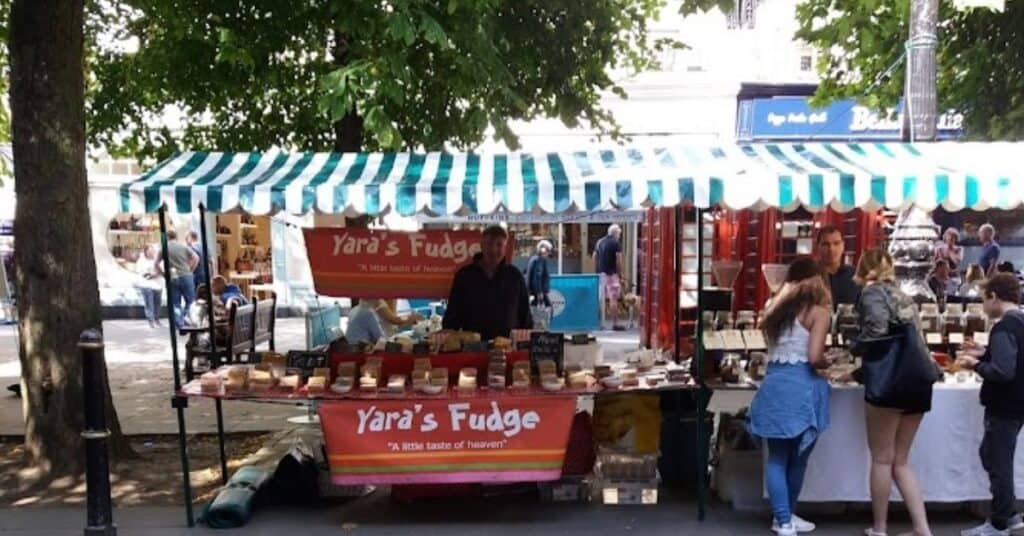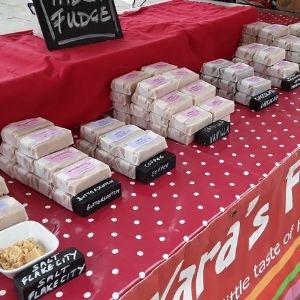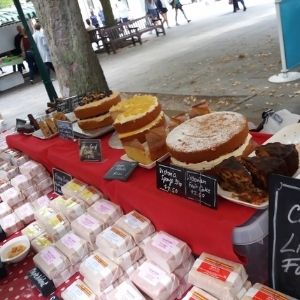
A day in the life of a Market Stall Seller is hard physical work, but working for yourself is motivational beyond measure. When your metaphorical cash register keeps ringing and your customers are always pleased to see you again – you know that you are onto a good thing and that this is the best job in the world.
Having traded at market stalls and events up and down the country, we know that if you have an entrepreneurial spirit and value your freedom and autonomy, then market trading is the way for you too. Here, we look at a day in the life of a Fudge Seller at a Gloucestershire market.
5.50 Friday – Market Day
When the alarm sounds, we both enthusiastically get out of bed. We both have a market on today. Dani at his regular pitch in Cirencester and me in Cheltenham. We had loaded up our vehicles last night and all we need now are our hot water flasks for our mandatory hand washing needs, a coffee to go, and I take my porridge ready to make mid morning. A quick kiss and Dani leaves first, for his one hour journey, eager to be one of the first to arrive to avoid the usual unloading bottleneck. I leave shortly after him on my 40 minute commute, just avoiding the Friday morning gridlock. We are generally one of the first stalls to arrive because we always try and avoid the morning traffic!
7.00 Unload
The great thing about Cheltenham market is that you can drive right up to your pitch and unload directly onto your stall. The stalls are pre-erected so no need to bring the heavy gazebo and tables to this one. First job is to get the tablecloth onto the table. Then everything else from the car gets put on top of that, still in boxes and bags. There are only about two other stallholders who have arrived and are unloading, out of the usual 30. A few ‘morning’s all around and back in the car to find the cheap parking spaces – it is understood that more in depth greetings are reserved for later. As the market manager is on site, the stock will be safe, I just have my float with me now.

Once parked, I walk back to the marketplace and pop into the coffee shop to use their facilities and to sit for a while to warm up with a drink. I can see the market from here and waste a little time until more stallholders arrive.
8.00 Set Up
If the weather is wet, I leave opening my boxes and putting my stock out until the very last moment. Side sheets will have been erected onto the stalls to offer more stock protection. This is quite an expensive market at £32 but the extra care given by the market operator is worth it. To protect boxes and bags from the wet pavement under the table I bring along a groundsheet to lay the empty boxes on top of. Dani and I always lay out our stall in the same way to give the brand consistency and one that is easily recognised wherever we are trading. Red spotty oil cloth tablecloth (great for wiping down), fudge bars in rows left to right, little wooden blocks painted black with white paint writing showing the flavours, empty stock boxes behind them covered with a red tablecloth and big banner behind or in front of us.

9.00 Ready To Trade
At this point I get tasters ready in little pots, laid out on the table for folk to help themselves to. You know you will get the grazers who will scoff as much ‘free’ fudge as they can, while giving you the ‘innocent’ look but you come to recognise the usual culprits and spot them before they get to you and remove your tasters – sharpish! This is often the calm before the serious business of buying takes place and it offers the chance to have a little walk about chatting to fellow stallholders (who are now your friends) and finding out what’s what. From food festivals that have opened their applications to the best place to buy stock or much more interesting – what the latest gossip is. “Did you hear about Joe’s latest nutty customer?” And laughs all around! Stories and more stories come out on a market between serving your regulars and persuading new ones that your wares are worthy of sampling.

Lunchtime
When trading in a town, lunchtime is when the serious business of earning money happens – particularly if you are serving food. Folk come out on their lunch breaks and are ready to spend. Even more lucrative is if the town hosts large events, like the Cheltenham Festival (horseracing) where folk come for miles around and pass your stall on their way to the races or Literary Festivals etc. Town events bring in large quantities of people who would otherwise not be there and they are excited to see that a market is on in the town. Win, win. If your trading place is a tourist destination it is also a great place to trade.
Folk always buy our 3 x £10 offer so our average sale is £10. Individual price is £4 so the pricing encourages the higher spend. When we have new flavours we always offer a taster of that one and it always flies out. Whichever flavour we offer the taster of, we sell much more of. When the piles of fudge start diminishing, I re-arrange the display bringing the stock nearer and nearer the centre as flavours begin to sell out. I am forever wiping down the cloth where tasters have been spilt, wiping out the taster pots and cutting up new tasters.
Catching up with customers that we see twice a month, finding out about their latest family stories or what their neighbours have asked them to buy from us is a lovely part of the interaction. Some just buy and leave, others like to linger and have a laugh. Being a market trader is not only to sell your wares, it is also to be a part of the fabric of the community. Individual stallholders are recognised as are customers and passers by. Adding to the busy atmosphere is the occasional busker who may be very good or usually, very bad. Hearing the same tune on repeat is enough for you to pay them to leave sometimes!
Being at street level you do see the rich tapestry of life right in front of you. From the relatively affluent who buy from the farmers’ market to the street dweller who is grateful for a taste of fudge, just for something to eat. As you continue to trade at the same spot for over 15 years, your own life journey is mirrored back at you. You see your regulars age and sometimes becoming infirm. When your older regulars just stop coming, you assume the worst. One relatively young customer told me that she had been diagnosed with a terminal illness but she still kept coming every month. Getting more and more frail as time went on, to wearing a head-scarf to using a walking stick, to her final farewell visit in a wheelchair.
Trading at a regular market, where your are known, is more a more relaxed affair than trading somewhere new. At a new venue you are working hard to attract customers to your stall. Smiling and making eye contact with everyone who passes, offering tasters and being at the ready to introduce your brand to folk who may be nervous to approach a new stall. You are on high alert, your senses seeking out every opportunity. You are also building rapport with your neighbouring stallholders, always trying to work out if this new market is suitable for your brand, if it is worth the extra travelling time and if it may be a good market to add to your monthly repertoire.
2.00 Packing Up
Some market days are better than others. Same market, different weather. A rainy market day will have the potential to halve your regular income whereas a lovely sunny day can increase your income by half. Luckily we live in an era where weather predictions are good and we can make stock according to what we think we have the potential to earn. If you can, take a bit more stock than you’ll think you will need and you won’t have to take much stock home with you. You will want enough stock to make your stall look full and interesting, but not so much that it will spoil if you don’t sell it. Luckily our product has a 6 week shelf life and we run multiple markets a week, so this is not a problem as our stock is always turning over.
It is now time to put all remaining stock back into its boxes, gather up banners, price signs and taster pots. Wipe and spray clean the table cloth and pile everything onto top of the stall table and collect the car. Luckily this particular market has a drive-in system where you can just drive by your stall, open your boot, pile everything in and drive off. Waving to everyone, saying see you next time, or tomorrow, if they are at the same market as you the next day. With heavy money belts hanging lower than they were first thing, a good market day means that we all leave with a smile but worry that we may not have enough stock for tomorrow’s market day.
4.30 Home
Dani and I are both home and have unloaded the stock back into the house. The first job is to assess what stock we both have left and re-distribute the flavours between us, collect more stock and hope that we have enough for our Saturday markets. Then and only then, do we relax and enjoy the best part of the day, counting up our takings! We are both fairly competitive so this is an important ritual for us. Dani usually beats me here, because his market goes on for one more hour and that extra hour goes into the time of day that people’s blood sugar is often low! (That’s my excuse anyway) My market usually brings in about £200 and Dani’s is around £300.

We often eat food that we have swapped at the market that day, like one of Nigel’s famous pies or Julia’s vegan lentil bake along with Anna’s gorgeous salads! After supper when the sun has gone down, us still with wind-blown red cheeks, we will load our stock back into our vehicles ready for our Saturday markets. We will have an early night and set our alarm for the whole process to begin again at Bath Farmers’ Market and at Malvern Farmers’ Market.
The Week at a Glance
Our week usually begins on a Monday, when we don’t have a market to go to. We need to get our stock levels back up. The first day will involve going to Costco, Booker or Supermarkets to buy all of our raw materials. Any online ordering will happen here too, perhaps getting bags delivered or specially sized greaseproof paper or business cards that have run out. Depending on the markets and shows that we have planned for the week ahead, we usually cook for 3/4 days and sell for 3/4 days. January and February are extremely slow months so we may go on holiday. October, November and the first part of December are extremely busy, so its all hands on deck there, usually co-opting in begrudging family members or keen friends to run stalls for us. We have had 5 stalls all running on the same day – just so we can take advantage of as much business as we can during the festive period, knowing that we will potentially have a few dormant months ahead of us in the new year.

The life of a market trader is exhilarating, because of your earning potential, the direct feedback you get from your customers, the camaraderie and laughter you experience with fellow traders and the sheer freedom you have because you are choosing your own destiny. You choose your own products, your markets, what days you work as you create your own brand. All of your business acumen is tested, stretched and improved. Every day you learn a new technique or a new potential business opportunity. You learn what not to do, often by your own embarrassing mistakes or by someone else’s misfortune! The life of a market trader is perfect if you love people, are motivated by money and are adaptable beyond measure.
Happy Trading!
